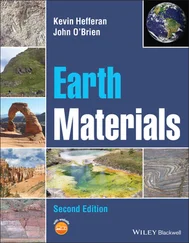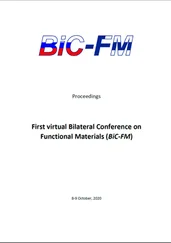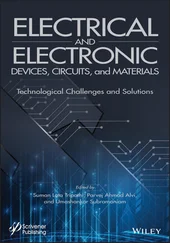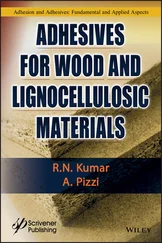Jing-Feng Li - Lead-Free Piezoelectric Materials
Здесь есть возможность читать онлайн «Jing-Feng Li - Lead-Free Piezoelectric Materials» — ознакомительный отрывок электронной книги совершенно бесплатно, а после прочтения отрывка купить полную версию. В некоторых случаях можно слушать аудио, скачать через торрент в формате fb2 и присутствует краткое содержание. Жанр: unrecognised, на английском языке. Описание произведения, (предисловие) а так же отзывы посетителей доступны на портале библиотеки ЛибКат.
- Название:Lead-Free Piezoelectric Materials
- Автор:
- Жанр:
- Год:неизвестен
- ISBN:нет данных
- Рейтинг книги:5 / 5. Голосов: 1
-
Избранное:Добавить в избранное
- Отзывы:
-
Ваша оценка:
- 100
- 1
- 2
- 3
- 4
- 5
Lead-Free Piezoelectric Materials: краткое содержание, описание и аннотация
Предлагаем к чтению аннотацию, описание, краткое содержание или предисловие (зависит от того, что написал сам автор книги «Lead-Free Piezoelectric Materials»). Если вы не нашли необходимую информацию о книге — напишите в комментариях, мы постараемся отыскать её.
Lead-Free Piezoelectric Materials
Lead-Free Piezoelectric Materials
Lead-Free Piezoelectric Materials — читать онлайн ознакомительный отрывок
Ниже представлен текст книги, разбитый по страницам. Система сохранения места последней прочитанной страницы, позволяет с удобством читать онлайн бесплатно книгу «Lead-Free Piezoelectric Materials», без необходимости каждый раз заново искать на чём Вы остановились. Поставьте закладку, и сможете в любой момент перейти на страницу, на которой закончили чтение.
Интервал:
Закладка:
Compared with other lead‐free piezoelectric systems, the BNT system exhibits an exceptionally high electric‐field‐induced strain, which makes it particularly attractive for applications in piezoelectric actuators such as camera focusing, printing nozzle, and impact driving. It has been reported that the poling strain of BNT–BaTiO 3ceramics could reach a high value range of 0.3–0.7% by composition modification [43, 44]. However, one of the drawback of BNT‐based ceramics is the existence of a depolarization temperature (approximately 150 °C) below the Curie point, which poses a limit on the application temperature, and its underlying mechanism is still not completely understood.
2.5 BiFeO 3
Bismuth ferrite (BiFeO 3) possesses a rhombohedrally distorted perovskite structure as shown in Figure 2.6, which can be denoted as a pseudocubic structure with lattice parameter a = 0.396 nm and α = 89.6° [45]. BiFeO 3is the only room‐temperature multiferroic material with coexisting ferroelectric and magnetic properties in a single compound [46]. Extensive studies have been conducted on this compound in the form of thin films, which are expected to open up new applications [47]. As reported in the epitaxial thin films, BiFeO 3has a high Curie point ( T c~ 830 °C) and large remnant polarization ( P r~ 100 μC/cm 2) at the same time [47]. In addition, the cost of resource is low because of the earth abundance of the constituent elements. Most importantly, BiFeO 3is a lead‐free ferroelectric compound where Bi has a similar electronic structure with Pb. Therefore, recently, increasing attention has been paid to the development of BiFeO 3‐based lead‐free piezoelectrics.
However, BiFeO 3and BiFeO 3‐based ceramics have high leakage current issues, mainly induced by defects and secondary phases, which hinder the poling process required for piezoelectric ceramics [48]. To resolve this problem, extensive investigations have been conducted based on chemical modifications to BiFeO 3[49]. In 2008, Takeuchi and coworkers introduced another rhombohedral–orthorhombic (R–O) MPB that was formed by A‐site doping with 14% Sm in BiFeO 3films grown on SrTiO 3. The piezoelectric coefficient d 33near this MPB could reach 110 pm/V [50]. This report stimulated many studies about Sm‐doping on BiFeO 3, and the addition of other rare earth elements were also investigated to promote the piezoelectricity and ferroelectricity. For example, a large piezoelectricity ( d 33≈ 50 pC/N) was reported in Sm and La co‐doped BiFeO 3ceramics [51]. Higher properties are obtained in BiFeO 3ceramics with the addition of ABO 3. In a study by Lee et al., excellent piezoelectric properties with a Curie temperature above 400 °C were reported in BiFeO 3–BaTiO 3ceramics with the addition of either Bi 1.05GaO 3or Bi 1.05(Zn 0.5Ti 0.5)O 3fabricated in a sintering‐and‐quenching process [52]. Such a special process has proved to effectively suppress the formation of point defects and secondary phase and thereby reduce the high current leakage [53].

Figure 2.6 Crystalline structure of BiFeO 3.
The main applications of BiFeO 3‐based ceramics are considered to be high‐temperature piezoelectric sensors, but their lower usage temperatures should be lower as compared with bismuth layer‐structured ferroelectric ceramics (BLSFs). Nevertheless, BiFeO 3‐based ceramics have the potentials to achieve much higher piezoelectric coefficients, so their applications can be extended to broader areas including piezoelectric actuators and transducers at middle and high temperatures.
2.6 Summary
For decades, Pb(Zr,Ti)O 3(PZT)‐based ceramics have been market‐dominating due to its excellent properties and flexibility in terms of compositional modifications. On the other hand, developing high‐performance lead‐free piezoelectric ceramics has been one of the most active materials research topics in the last decades. At present, a single replacement for PZT may not be available, but the abovementioned lead‐free systems are already applicable for some applications. Among them, KNN appears to be the most promising one for its well‐balanced combination of high piezoelectricity and Curie temperature. In addition, as shown in Chapter 3, KNN‐based ceramics can be co‐fired with base metals like nickel, which is a critical factor for the cost‐effective fabrication of multilayered piezoceramic actuators. Certainly, other systems also have certain advantages, such as large piezoelectric strains in BNT‐based ceramics and high Curie temperature in BiFeO 3‐based ceramics. However, all these known lead‐free materials are unlikely to be such an “all‐round player” that can be modified to exhibit different properties by changing doping elements as in PZT, so there still needs a further long way to develop lead‐free piezoceramics that are completely capable of replacing PZT‐based ceramics.
References
1 1 Gagliardi, M. (2019). Lead‐free piezoelectric ceramics market projected to grow at much faster pace through 2024. American Ceramic Society Bulletin 99: 7.
2 2 Jaffe, B., Cook, W.R., and Jaffe, H. (1971). Piezoelectric Ceramics. Academic Press.
3 3 Sawaguchi, E. (1953). Ferroelectricity versus antiferroelectricity in the solid solutions of PbZrO3 and PbTiO3. Journal of the Physical Society of Japan 8: 615–629.
4 4 Jaffe, B., Roth, R.S., and Marzullo, S. (1955). Properties of piezoelectric ceramics in the solid‐solutions series lead titanate–lead zirconate–lead oxide: tin oxide and lead titanate–lead hafnate. Journal of Research of the National Bureau of Standards 55: 239–254.
5 5 Noheda, B., Cox, D.E., Shirane, G. et al. (1999). A monoclinic ferroelectric phase in the Pb(Zr1−xTix)O3 solid solution. Applied Physics Letters 74: 2059–2061.
6 6 Noheda, B., Gonzalo, J.A., Cross, L.E. et al. (2000). Tetragonal‐to‐monoclinic phase transition in a ferroelectric perovskite: the structure of PbZr0.52Ti0.48O3. Physical Review B 61: 8687–8695.
7 7 Wang, H., Zhu, J., Lu, N. et al. (2006). Hierarchical micro‐/nanoscale domain structure in M‐C phase of (1−x)Pb(Mg1/3Nb2/3)O3−xPbTiO3 single crystal. Applied Physics Letters 89: 042908.
8 8 EU‐Directive 2002/95/EC (2003). Restriction of the Use of Certain Hazardous Substances in Electrical and Electronic Equipment (RoHS). Official Journal of the European Union 46 (L37): 19.
9 9 Roedel, J. and Li, J.‐F. (2018). Lead‐free piezoceramics: status and perspectives. MRS Bulletin 43: 576–580.
10 10 Saito, Y., Takao, H., Tani, T. et al. (2004). Lead‐free piezoceramics. Nature 432: 84–87.
11 11 Jona, F. and Shirane, G. (1962). Ferroelectric Crystals. Oxford, UK: Pergamon Press.
12 12 Merz, W.J. (1949). The electric and optical behavior of BaTiO3 single‐domain crystals. Physical Review 76: 1221–1225.
13 13 Acosta, M., Novak, N., Rojas, V. et al. (2017). BaTiO3‐based piezoelectrics: fundamentals, current status, and perspectives. Applied Physical Review 4: 041305.
14 14 Gao, J., Ke, X., Acosta, M. et al. (2018). High piezoelectricity by multiphase coexisting point: barium titanate derivatives. MRS Bulletin 43: 595–598.
15 15 Wada, S., Yako, K., Kakemoto, H. et al. (2005). Enhanced piezoelectric properties of barium titanate single crystals with different engineered‐domain sizes. Journal of Applied Physics 98: 014109.
16 16 Ren, X.B. (2004). Large electric‐field‐induced strain in ferroelectric crystals by point‐defect‐mediated reversible domain switching. Nature Materials 3: 91–94.
Читать дальшеИнтервал:
Закладка:
Похожие книги на «Lead-Free Piezoelectric Materials»
Представляем Вашему вниманию похожие книги на «Lead-Free Piezoelectric Materials» списком для выбора. Мы отобрали схожую по названию и смыслу литературу в надежде предоставить читателям больше вариантов отыскать новые, интересные, ещё непрочитанные произведения.
Обсуждение, отзывы о книге «Lead-Free Piezoelectric Materials» и просто собственные мнения читателей. Оставьте ваши комментарии, напишите, что Вы думаете о произведении, его смысле или главных героях. Укажите что конкретно понравилось, а что нет, и почему Вы так считаете.












